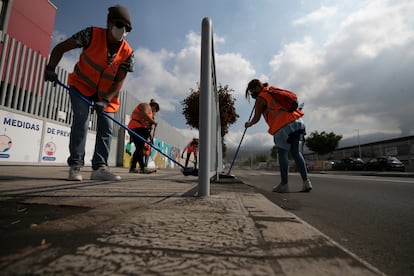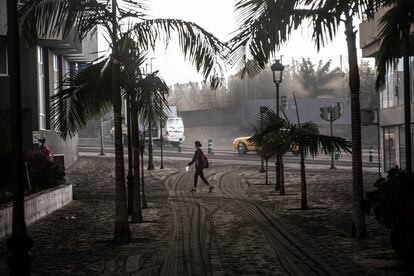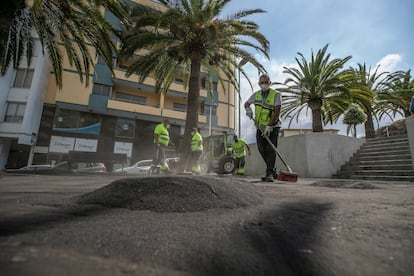The neverending job of sweeping up the volcanic ash on La Palma
Municipal street cleaners in Los Llanos are faced with an arduous and frustrating job, given the non-stop grey powder that’s being spewed out by the eruption on the Canary Island. “It’s like using a sledgehammer to crack nuts,” one explains


It’s easy to spot the cars that have been parked the longest in Los Llanos de Aridane – the thickness of the ash that covers them sets them apart. You can also identify the streets that see fewer passers-by, given the lack of footprints in the layer of grey powder that is covering the floor, as if it had snowed. However, the ash doesn’t melt away, and just keeps piling up on La Palma, day after day.
The new volcano on the Canary Island, a Spanish archipelago located off the northwestern coast of Africa, has been erupting now since September 19. The ash that it is spewing out doesn’t leave your face wet, like snow or rain, but instead gets in your eyes, which start to smart straight away, and even in your mouth. “It really stings, it’s horrible,” explains Melani Rodríguez, with a brush in her hand. This 25-year-old woman is one of the people who have been hired by the local council in Los Llanos to help clean up the streets, which are in a critical condition due to the volcanic eruption.
This past Saturday saw a record emission of ash since the eruption began, and it was falling intensely on the island until midday Monday. “We haven’t seen it like this until now,” explains Airam Castro, a 36-year-old municipal employee. “It’s impossible to clear what’s been falling. It’s like using a sledgehammer to crack nuts.” Los Llanos has been buried by the ash.
“This is really tough,” adds Milagros Armas, 44. “This is not a normal cleaning job, where you change your position. It’s the same movement with the sweeper the whole time and your muscles end up stiff. And the ash weighs more than trash.”
Next to her, Rodríguez dries off her forehead with her hand. She’s wearing an FPP2 mask. When she lowers it slightly there is a black line on her face, as if it had been drawn with a pencil. There are five more women with them, all armed with sweepers. They’re cleaning the entrance to an elementary school, and all are wearing glasses or protective screens. “You do everything you can to avoid scratching your eyes, but you can’t avoid it,” Armas explains. “You have to put in eye drops all of the time.”

Armas and her colleagues work with a kind of choreography, in a routine that they’ve been perfecting over recent weeks. With each brush stroke they remove a portion of the ash, but there’s always a fine film of it left on the floor. “It’s almost impossible to get rid of this powder,” says Armas. The ash has forced her to temporarily separate from her six-year-old son. “I’ve had to send my child to Tenerife because he has allergy problems,” she explains. “That’s left me depressed.” There is no let-up when the work day is over. “When you get home you carry on cleaning because the ash gets everywhere,” she says angrily, but straight away changes her tone to express her pride. “We feel useful because we are doing something that we know is very important,” she insists.
These seven women and the rest of the cleaning crew in Los Llanos are a shield against the interruption that the ash is causing in the lives of local residents. The powder has buried pathways and small buildings in the evacuated areas where the lava has not reached.
“It’s getting worse and worse,” explains the councilor in Los Llanos for municipal services, José María Rivera. “All we can do is keep sweeping and sweeping.” He says that he is worried about the combination of the ash and the coronavirus pandemic. “To disinfect surfaces because of Covid-19 the staff have to use water, but you can’t mix it with the ash. It’s all very complicated.”
When the ash from the volcano gets wet it weighs more, explains Miguel Ángel Morcuende, who is the technical director from the team of experts monitoring the phenomenon, the Volcano Risk Prevention Plan (Pevolca). It turns into a kind of cement that’s very difficult to move. It presents the biggest risks for water pipes, given that they could become blocked, as well as on roofs, which could collapse under the weight.
The volcano is expelling a column of gases and particles that are reaching between 3,000 and 5,000 meters high. The ash is falling mostly on the west of the island, where the volcano and municipalities such as Los Llanos are located.
According to the latest calculations from the European Union’s Earth observation program Copernicus, there are 6,800 hectares of land already covered by the ash – that’s about 10% of the total surface area of La Palma. The quantity of ash that falls differs from day to day, with barely any some days and others when observers can’t even see the sky.

There are 11 municipal employees who are working to clean the streets of Los Llanos and another 17 who have been deployed exclusively at schools. They are being helped by another 22 back-up staff thanks to an employment plan from the council, and also teams who have been sent from other areas of the Canary Islands. One of those is led by Juan Carlos Lorenzo, 52. “There isn’t a single street that you see without thinking, ‘God protect us,’” explains this team leader from Tenerife. He and his colleagues are working with a vehicle that has a shovel with capacity for one cubic meter of ash – the equivalent of 1,000 liters of water. The workers fill it up after moving just 80 meters along Enrique Mederos street, after first having shoveled the ash into little piles.
Why would we clean it all up when it will just be the same later? It’s really terribleCleaning team leader Juan Carlos Lorenzo
A child tries to step on one of these piles, but his mother stops him with a shout. “It doesn’t look like it, but the ash is actually very slippery,” Lorenzo explains. “It’s dangerous for cars on the roads as well as for seniors on the sidewalks. After the weekend, with all of this that has fallen, we can’t even hope to remove all of it, but rather leave as fine a layer as possible. Why would we clean it all up when it will just be the same later? It’s really terrible.”
Teams of volunteers are also battling against the ash, but those who are doing most to get rid of it are the storekeepers and residents who are constantly removing the grey blanket from their doors and roofs. One of them is Jessica, 38, who on Monday was glumly sweeping the sidewalk on La Pasión street. “It’s been horrible,” she complains. “What’s more, the ash is really fine, it gets everywhere and it’s really heavy. It’s impossible to get rid of it all. I’m tired, it’s the same thing all day.”
José Enrique Castro, who is 62 and is the father of Airam, is also a municipal street cleaner. He’s trying to be positive. “The ash that you collect today is not the same as what you’re going to pick up the next day, and it all has to be removed,” he argues. He thinks that three or four months with no ashfall whatsoever will be needed before the place can be completely cleaned up. “But it doesn’t seem like that will happen anytime soon, so we’ll carry on with our job while the volcano carries on with its job.” In the meantime, while the “monster” continues to roar in the background, he gets back on his street cleaning machine, which sucks up the ash through a vacuum system. Before the eruption of the new volcano, it would take two days to fill the vehicle with trash. Now he has to empty it every two hours.
Tu suscripción se está usando en otro dispositivo
¿Quieres añadir otro usuario a tu suscripción?
Si continúas leyendo en este dispositivo, no se podrá leer en el otro.
FlechaTu suscripción se está usando en otro dispositivo y solo puedes acceder a EL PAÍS desde un dispositivo a la vez.
Si quieres compartir tu cuenta, cambia tu suscripción a la modalidad Premium, así podrás añadir otro usuario. Cada uno accederá con su propia cuenta de email, lo que os permitirá personalizar vuestra experiencia en EL PAÍS.
¿Tienes una suscripción de empresa? Accede aquí para contratar más cuentas.
En el caso de no saber quién está usando tu cuenta, te recomendamos cambiar tu contraseña aquí.
Si decides continuar compartiendo tu cuenta, este mensaje se mostrará en tu dispositivo y en el de la otra persona que está usando tu cuenta de forma indefinida, afectando a tu experiencia de lectura. Puedes consultar aquí los términos y condiciones de la suscripción digital.
More information

One month on, La Palma volcano continues to cause destruction
Últimas noticias
Most viewed
- Reinhard Genzel, Nobel laureate in physics: ‘One-minute videos will never give you the truth’
- Oona Chaplin: ‘I told James Cameron that I was living in a treehouse and starting a permaculture project with a friend’
- Pablo Escobar’s hippos: A serious environmental problem, 40 years on
- Chevy Chase, the beloved comedian who was a monster off camera: ‘Not everyone hated him, just the people who’ve worked with him’
- Why we lost the habit of sleeping in two segments and how that changed our sense of time









































